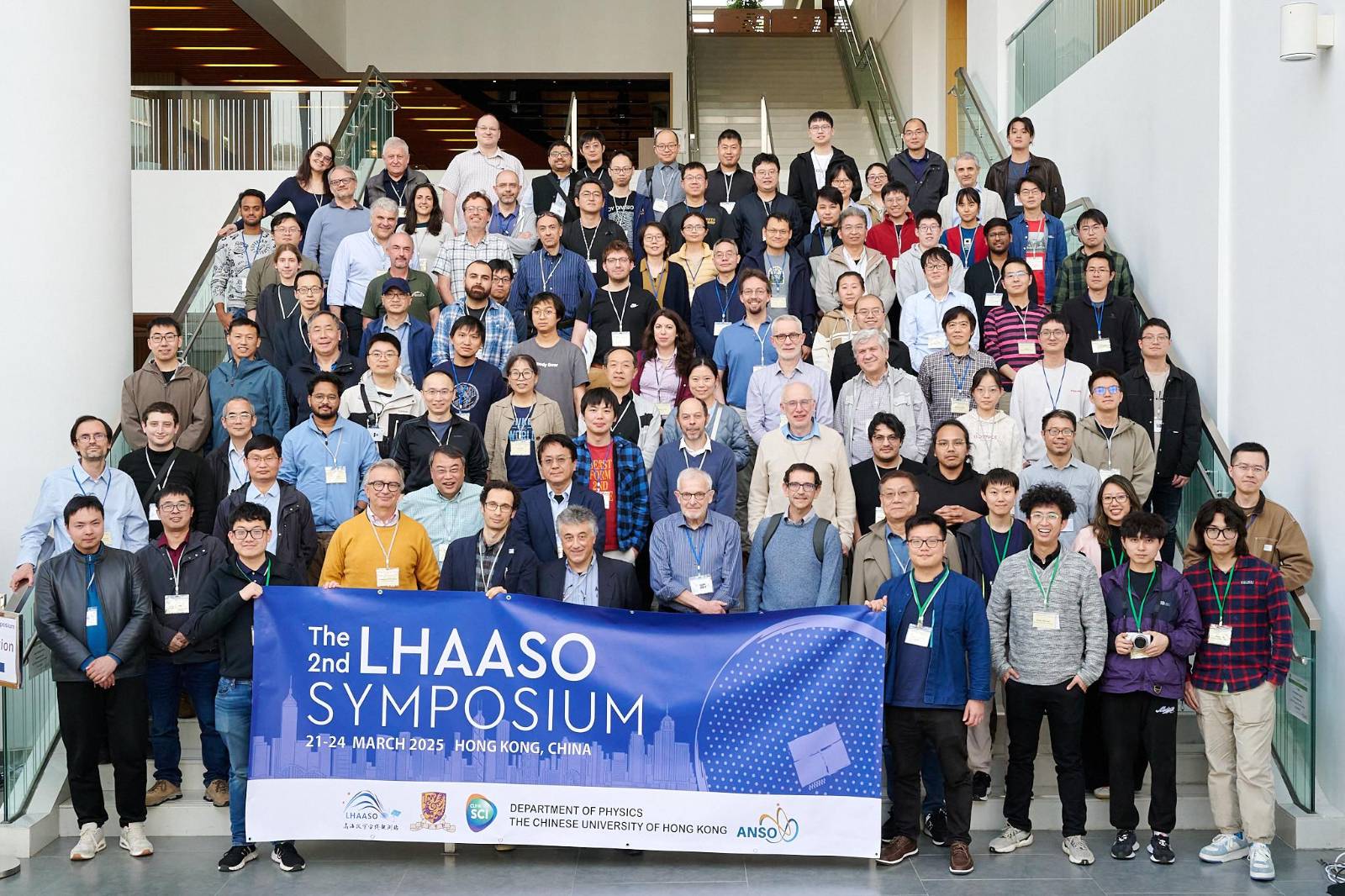The 2nd LHAASO Symposium
Henry Cheng International Conference Center
LHAASO (Large High Altitude Air Shower Observatory) has provided crucial insights into the origin and nature of cosmic rays, particularly in the ultra-high-energy regime. Its results also have implications for multi-messenger astronomy, as LHAASO can detect gamma rays in coincidence with other messengers, such as neutrinos and gravitational waves.
This international symposium aims to bring together experts and scholars from around the world to discuss the latest research findings of LHAASO and their corresponding implications in various aspects of astrophysics, including cosmic ray physics and multi-messenger astronomy. We hope that this symposium will foster academic exchange and collaboration, and deepen our understanding of the significance and importance of the LHAASO experiment in advancing our knowledge of the universe.
The 2nd LHAASO symposium will be hosted by the Chinese University of Hong Kong at Hong Kong, China from March 20th to March 25th. On-site registration will begin on the March 20th, the main conference will take place from 21st to 24th, and the 25th is reserved for discussion.
Zoom link:
https://cuhk.zoom.us/j/96796012422?pwd=k5fnT6s6ozvnBwmqa6ykNfPgLNbmnZ.1
Acknowledgements
We gratefully acknowledge the generous support provided by the Institute of Theoretical Physics, the Faculty of Science, and the CAS-ANSO Conference Program. Their contributions were instrumental in making this conference a success.


===========================
Invited Speaker list
| Felix Aharonian | Gwenael Giacinti | Enrico Peretti |
| Katsuaki Asano | Francis Halzen | Giada Peron |
| Maxim Barkov | Sergio Hernández-Cadena | Tanguy Pierog |
| Pasquale Blasi | Shicong Hu | Sarah Recchia |
| Markus Boettcher | Tianqi Huang | Brian Reville |
| Niccolo Bucciantini | Susumu Inoue | Dmitri Semikoz |
| Zhen Cao | Kang Jia | Giorgia Sironi |
| Sabrina Casanova | Shigero Kimura | Andrew Taylor |
| Silvia Celli | Cong Li | Diego Torres |
| Songzhan Chen | Zhe Li | Jieshuang Wang |
| Silvia Crestan | Ruoyu Liu | Kai Wang |
| Roland Crocker | Lingling Ma | Sha Wu |
| Jane Lixin Dai | Masahiro Teshima | Huirong Yan |
| Paolo Desiati | Alison Mitchell | Ruizhi Yang |
| Giuseppe Di Sciascio | Kaya Mori | Qiang Yuan |
| Ralph Engel | Giovanni Morlino | Chuan Yue |
| Carmelo Evoli | Igor Moskalenko | Min Zha |
| Yizhong Fan | Kohta Murase | Xiao Zhang |
| Hua Feng | Gor Oganesyan | Shoushan Zhang |
| Stefano Gabici | Giovanni Pareschi | Yi Zhang |
| Siming Liu | Gabriele Ponti | Heshou Zhang |
ABDULHAFIZ AHMED MUSTOFA
Alamgir Khan
Alice Harding
Alison Mitchell
Andrew Taylor
Ata Ul Haleem Damanik
Benjamin Obot
Bing Liu
Bing Theodore (兵) Zhang (张)
Boris Hoi-Lun Ng
Carmelo Evoli
chao Hou
Chaoming Li
Chaymae Karam
Che Li
Chengchao Yuan
Cheuk Nam Chong
Chingam Fong
Cong Li
Cunfeng feng
Diego Torres
Dmitri SEMIKOZ
Eiji Kido
Enrico Peretti
Felix Aharonian
Francesca Melchiori
Francis Halzen
Gabriele Ponti
Giada Peron
Giorgia Sironi
Giovanni Morlino
Giovanni Pareschi
Giuseppe Di Sciascio
Gor Oganesyan
Guangshun Huang
Gunindra Krishna Mahanta
Guohai Chen
Gwenael Giacinti
Haina Huang
Hao Zhou
Hao-Ning He
Heshou Zhang
Ho Ching Luk
Houbing Jiang
Houdun Zeng
Hua Feng
Huicai Li
Huirong Yan
Igor Moskalenko
Jane Dai
Jianhao WU
Jianli Zhang
Kai(凯) Wang(汪)
Kang Jia
Katsuaki Asano
Kaya Mori
Kenny Chun Yu Ng
Kohta Murase
Kristy Fu
Lihong Wan
lingling Ma
Lingyu Xia
Markus Boettcher
Masahiro Teshima
Maxim Barkov
Min ZHA
Ming-chung Chu
MUHAMMAD FAROOQ
Niccolo Bucciantini
Pak Hin Tam
Paolo Coppi
Paolo Desiati
Paolo Lipari
PARTHA SARATHI PAL
Pasquale Blasi
Qiang Yuan
Qingzhong Liu
Qishan Liu
Ralph Engel
Ramiro Torres-Escobedo
Rishank Diwan
Roland Crocker
Rui HU
Ruizhi Yang
Ruoyu Liu
Sabrina Casanova
Samanta Macera
Samy Kaci
Sarah Recchia
Sengo Francois Kone
Sergio Hernández Cadena
Sha Wu
Shaoqiang Xi
Shicong Hu
Shigeo Kimura
Shing Him Tse Tse
Shiqi Yu
Shoushan Zhang
Shumeng Zhang
Silvia Celli
Silvia Crestan
Siming Liu
Siu Hei Cheung
songzhan(松战) CHEN(陈)
Sovan Boxi
Stefano Gabici
Stephen C.-Y. Ng
Susumu Inoue
Tanguy Pierog
Tian-Qi Huang
Tsang Keung Chan
Wangzheng Zhang
Xiang Li
Xiao ZHANG
Xiao-Jun Bi
Yi Xing
Yi Zhang
Yifan Sun
Yifeng Wei
Yihan Liu
Yiwei Bao
Yizhong Fan
yu zhang
Yunfeng Liang
Yunlong Zhang
Zhe Li
zhen cao
Zhiyong You
Zhuochao LI
Ziwei Ou
剑 李
子豪 赵
川 岳
源 李
玮真 张
睿仪 唐
